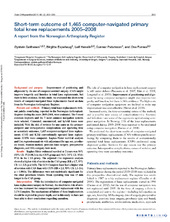Short-term outcome of 1,465 computer-navigated primary total knee replacements 2005–2008. A report from the Norwegian Arthroplasty Register
Peer reviewed, Journal article
Published version

View/
Date
2011-06Metadata
Show full item recordCollections
Abstract
Background and purpose: Improvement of positioning and alignment by the use of computer-assisted surgery (CAS) might improve longevity and function in total knee replacements, but there is little evidence. In this study, we evaluated the short-term results of computer-navigated knee replacements based on data from the Norwegian Arthroplasty Register. Patients and methods: Primary total knee replacements without patella resurfacing, reported to the Norwegian Arthroplasty Register during the years 2005–2008, were evaluated. The 5 most common implants and the 3 most common navigation systems were selected. Cemented, uncemented, and hybrid knees were included. With the risk of revision for any cause as the primary endpoint and intraoperative complications and operating time as secondary outcomes, 1,465 computer-navigated knee replacements (CAS) and 8,214 conventionally operated knee replacements (CON) were compared. Kaplan-Meier survival analysis and Cox regression analysis with adjustment for age, sex, prosthesis brand, fixation method, previous knee surgery, preoperative diagnosis, and ASA category were used. Results: Kaplan-Meier estimated survival at 2 years was 98% (95% CI: 97.5–98.3) in the CON group and 96% (95% CI: 95.0– 97.8) in the CAS group. The adjusted Cox regression analysis showed a higher risk of revision in the CAS group (RR = 1.7, 95% CI: 1.1–2.5; p = 0.02). The LCS Complete knee had a higher risk of revision with CAS than with CON (RR = 2.1, 95% CI: 1.3–3.4; p = 0.004)). The differences were not statistically significant for the other prosthesis brands. Mean operating time was 15 min longer in the CAS group. Interpretation: With the introduction of computer-navigated knee replacement surgery in Norway, the short-term risk of revision has increased for computer-navigated replacement with the LCS Complete. The mechanisms of failure of these implantations should be explored in greater depth, and in this study we have not been able to draw conclusions regarding causation.
